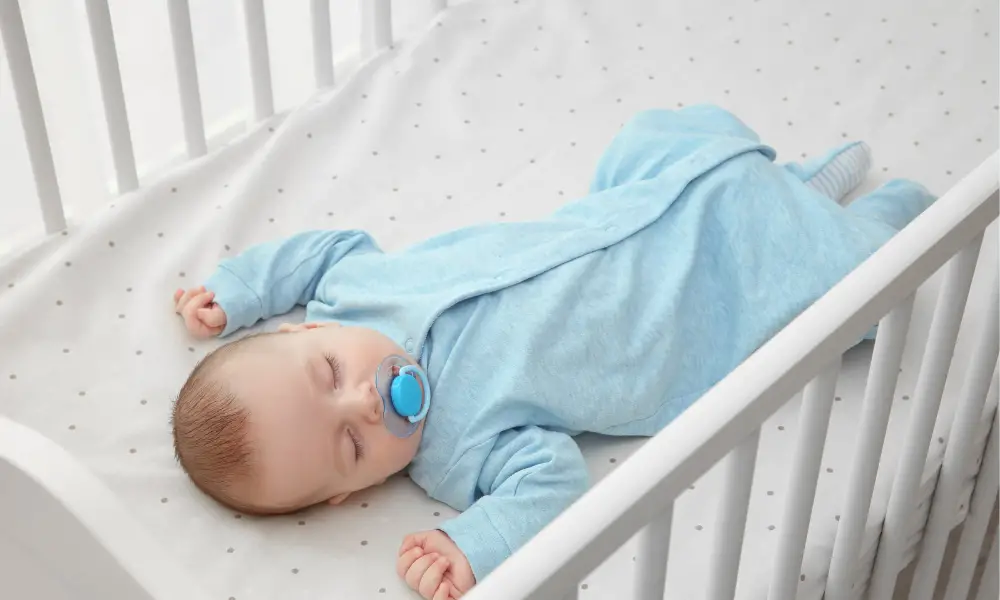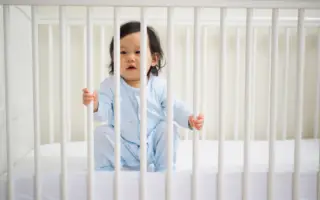Dress your baby in light, breathable fabrics for sleep. Adjust layers according to room temperature for comfort.
Dressing a baby for sleep requires careful consideration of comfort and safety. Choose light, breathable fabrics like cotton to avoid overheating. Adjust clothing layers based on the room’s temperature to ensure your baby stays warm but not too hot. Use sleep sacks or wearable blankets instead of loose bedding to reduce the risk of suffocation.
Always check your baby’s neck and chest to gauge warmth, ensuring they are neither too hot nor too cold. Keeping your baby comfortable and safe during sleep promotes better rest and overall well-being.
Table of Contents
Choosing The Right Sleepwear
Choosing the right sleepwear for your baby is crucial for their comfort and safety. Proper sleepwear helps regulate body temperature and ensures a good night’s sleep. This guide offers practical tips on selecting the perfect sleepwear for your little one.
Consider The Fabric
Fabric choice is vital for baby sleepwear. Babies have sensitive skin, so the fabric should be soft and breathable.
Cotton is a popular choice. It is soft, breathable, and gentle on the skin. Organic cotton is even better as it is free from harmful chemicals.
Bamboo fabric is another great option. It is incredibly soft, hypoallergenic, and has natural moisture-wicking properties. This keeps your baby dry and comfortable.
Avoid synthetic fabrics like polyester. They can cause overheating and may irritate the skin.
Here is a comparison table of suitable fabrics:
| Fabric | Benefits | Drawbacks |
|---|---|---|
| Cotton | Soft, breathable, hypoallergenic | May shrink after washing |
| Bamboo | Soft, moisture-wicking, hypoallergenic | More expensive than cotton |
| Polyester | Durable, inexpensive | Traps heat, can irritate skin |
Opt For The Right Size
Choosing the correct size for baby sleepwear ensures comfort and safety. Sleepwear should fit snugly but not too tight.
Check the manufacturer’s size chart before purchasing. Sizes can vary between brands. Measure your baby’s height and weight for a better fit.
Avoid loose or baggy sleepwear. Loose clothing can ride up and cover your baby’s face, posing a suffocation risk.
Consider these tips for selecting the right size:
- Choose footed pajamas for younger babies. They keep feet warm without the need for socks.
- Look for adjustable features. Waistbands and cuffs should be flexible but not tight.
- Check for growth room. Babies grow quickly, so consider sleepwear with a bit of extra room.
Here’s a quick size guide for reference:
| Age | Height (inches) | Weight (pounds) |
|---|---|---|
| 0-3 months | 19-23 | 7-12 |
| 3-6 months | 24-26 | 12-17 |
| 6-9 months | 27-28 | 17-21 |
| 9-12 months | 29-30 | 21-25 |
Always double-check the fit after putting sleepwear on your baby. Ensure it is snug but not restrictive.
What Should My Baby Wear To Sleep?
A proper sleep outfit can help regulate your baby’s body temperature and promote better sleep. Read on for ideas and guides on dressing your baby for sleep, focusing on both hot and cold weather.
Dressing For Hot Weather
In hot weather, it’s important to keep your baby cool and comfortable. Overheating can lead to discomfort and disrupt sleep. Here are some tips for dressing your baby for sleep during hot weather:
- Lightweight Onesies: Opt for breathable cotton onesies. They allow air to circulate and keep your baby cool.
- Short Sleeves: Short-sleeved onesies or t-shirts are ideal for hot nights.
- Avoid Socks and Hats: These can cause overheating. Let your baby’s feet and head stay uncovered.
You might wonder if a blanket is necessary. In hot weather, light blankets or no blanket at all is recommended. Here is a simple table to help you decide:
| Room Temperature | Recommended Sleepwear |
|---|---|
| Above 75°F (24°C) | Lightweight onesie or t-shirt and diaper |
| 70-75°F (21-24°C) | Short-sleeved onesie and light blanket |
Keeping your baby hydrated is also essential. Offer more breastmilk or formula to ensure they stay hydrated throughout the night.
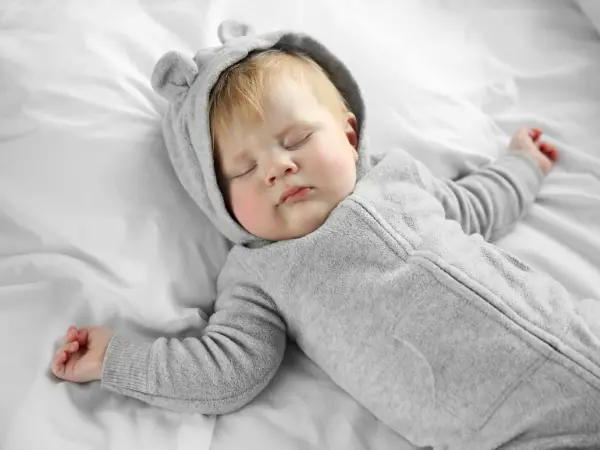
Layering For Cold Weather
When temperatures drop, your baby needs extra layers to stay warm. Cold weather can cause discomfort and make it difficult for your baby to sleep. Here are some tips for layering your baby for sleep during cold weather:
- Long-Sleeved Onesies: Use long-sleeved cotton onesies as the base layer to provide warmth.
- Sleep Sacks: Sleep sacks are a safe alternative to blankets. They keep your baby warm without the risk of suffocation.
- Footed Pajamas: Footed pajamas keep your baby’s feet warm and eliminate the need for socks.
Knowing how many layers to add can be tricky. Here is a table to guide you:
| Room Temperature | Recommended Sleepwear |
|---|---|
| 65-70°F (18-21°C) | Long-sleeved onesie and sleep sack |
| 60-65°F (15-18°C) | Footed pajamas and sleep sack |
If the room is very cold, consider adding a hat. Always check your baby’s neck and back to ensure they are not too hot or cold. Adjust layers accordingly.
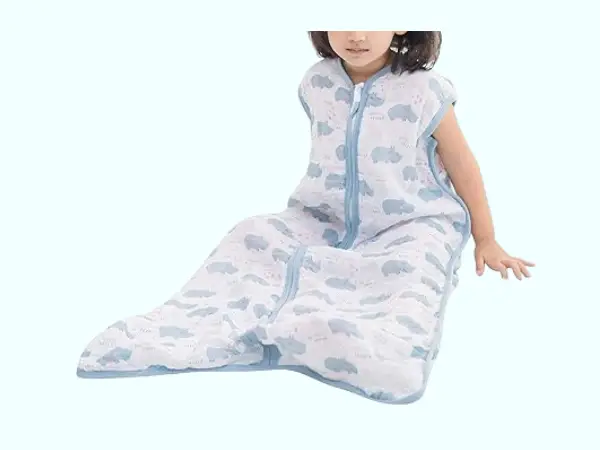
Safety Measures
Dressing your baby for sleep involves more than just choosing cute pajamas. Safety measures are crucial to ensure your baby sleeps soundly and securely.
Avoiding Loose Accessories
Loose accessories can be dangerous for your sleeping baby. They pose risks such as choking, suffocation, and entanglement. Here are some key points to consider:
- No loose blankets: Use a sleep sack or wearable blanket instead. Loose blankets can cover the baby’s face.
- Avoid hats: Babies regulate temperature through their heads. Hats can cause overheating.
- No jewelry: Items like necklaces or bracelets can be a choking hazard. Remove all jewelry before sleep.
Below is a table summarizing the risks of common accessories:
| Accessory | Risk |
|---|---|
| Loose Blankets | Suffocation |
| Hats | Overheating |
| Jewelry | Choking |
Checking For Proper Fit
A proper fit is essential for your baby’s sleepwear. Clothes that are too tight or too loose can cause discomfort and safety issues. Consider the following tips:
- Snug but not tight: Ensure the sleepwear fits snugly but allows your baby to move freely.
- No loose threads: Check for loose threads or buttons. These can be choking hazards.
- Right size: Always choose the right size for your baby’s age and weight.
Here is a simple checklist for ensuring a proper fit:
- Measure your baby’s size and weight.
- Choose sleepwear labeled for your baby’s measurements.
- Check for any loose parts or threads before dressing your baby.
By following these guidelines, you can help ensure your baby sleeps safely and comfortably.
Comfort And Movement
How you dress your baby for sleep can greatly impact their comfort and movement.
Prioritizing Comfort
Comfort is key when dressing your baby for sleep. Babies need soft, breathable fabrics to avoid irritation and overheating. Always consider the room temperature to choose the right clothing layers. Here are some tips:
- Choose soft fabrics: Cotton is a great choice as it is gentle on the skin.
- Avoid tags and seams: Tags and rough seams can irritate sensitive baby skin.
- Check for tightness: Ensure clothes are snug but not too tight to allow proper circulation.
Consider using a sleep sack or a wearable blanket. These are safer alternatives to loose blankets, reducing the risk of suffocation. Sleep sacks keep your baby warm and cozy without restricting movement.
| Room Temperature | Recommended Clothing |
|---|---|
| Below 60°F (15°C) | Long-sleeve onesie, footed pajamas, and a sleep sack |
| 60-68°F (15-20°C) | Long-sleeve onesie and a sleep sack |
| 68-72°F (20-22°C) | Short-sleeve onesie and a sleep sack |
| Above 72°F (22°C) | Light onesie or just a diaper with a sleep sack |
Allowing Freedom Of Movement
Babies need to move freely even while sleeping. Clothes that are too tight can restrict their natural movements and cause discomfort. Here’s how to ensure your baby can move freely:
- Opt for stretchy materials: Fabrics like cotton blends allow for more movement.
- Avoid overly tight clothing: Ensure the fit is snug but not restrictive.
- Check the fit frequently: Babies grow fast, so regularly check that their sleepwear isn’t too tight.
Consider using a swaddle for younger babies. Swaddling mimics the womb and can help them feel secure. Ensure the swaddle is not too tight and allows some leg movement. For older babies, a sleep sack with room for leg movement is ideal.
Here are some more tips:
- Check for mobility: Ensure your baby can kick their legs and move their arms.
- Avoid footed pajamas if they are too tight: These can restrict leg movement.
- Use layers: This allows you to adjust their clothing as needed without restricting movement.
Allowing freedom of movement ensures your baby stays comfortable and can move naturally, aiding better sleep.
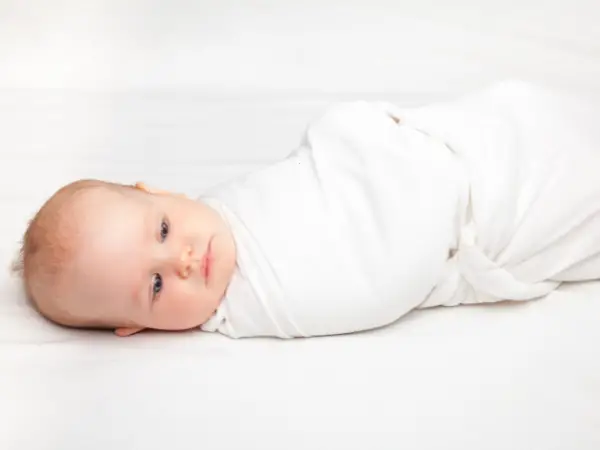
Tips For Newborns
Ensuring your newborn sleeps soundly involves more than just a comfy crib. Here are some essential tips for dressing newborns for sleep to help new parents make informed choices.
Choosing One-piece Outfits
One-piece outfits, such as footed pajamas or sleepers, are a top choice for newborns. These outfits keep the baby warm and eliminate the need for extra blankets, which can be a safety hazard. Look for materials like cotton or organic fabrics that are breathable and gentle on the baby’s skin.
Here are some key points to consider when choosing one-piece outfits:
- Opt for soft, breathable fabrics: Cotton is ideal as it helps regulate temperature.
- Ensure a snug fit: Loose clothing can ride up and cover the baby’s face.
- Check for easy diaper access: Look for onesies with snaps or zippers for quick changes.
- Avoid decorative elements: Buttons, bows, and other adornments can be uncomfortable.
Here’s a simple table to summarize the benefits of one-piece outfits:
| Feature | Benefit |
|---|---|
| Footed design | Keeps feet warm without socks |
| Snaps/Zippers | Easy diaper changes |
| Soft fabrics | Comfortable and breathable |
Considering Swaddling
Swaddling mimics the womb’s snug environment, helping newborns feel secure. It’s a technique that involves wrapping the baby in a blanket to restrict movement and promote sleep. Swaddle blankets made of cotton or muslin are excellent choices.
Follow these tips for effective swaddling:
- Use a lightweight, breathable blanket: This prevents overheating.
- Ensure the swaddle is snug but not too tight: The hips and legs should have some room to move.
- Keep the baby’s face uncovered: The blanket should be away from the face to reduce the risk of suffocation.
- Check the baby’s temperature: Ensure the baby isn’t too hot or cold.
Here is a step-by-step guide to swaddling:
- Lay the blanket flat and fold down one corner.
- Place the baby on the blanket, with the shoulders just below the fold.
- Wrap one side of the blanket over the baby, tucking it under the opposite arm.
- Fold the bottom of the blanket up over the baby’s feet.
- Wrap the other side of the blanket over the baby, securing it under the opposite side.
These tips ensure your newborn stays comfortable, safe, and secure during sleep. By choosing appropriate sleepwear and considering swaddling, you can enhance your baby’s sleep quality and overall well-being.
Sleepwear Accessories
Sleepwear accessories like sleep sacks, hats, and socks play a big role. They help regulate body temperature and offer a cozy sleeping environment.
Using Sleep Sacks
Sleep sacks are a fantastic alternative to blankets. They provide warmth without the risk of suffocation. Here are some benefits of using sleep sacks:
- Safe Sleeping Environment: Sleep sacks reduce the risk of loose blankets covering your baby’s face.
- Temperature Regulation: They help keep your baby at a consistent temperature, avoiding overheating.
- Easy to Use: Most sleep sacks come with zippers or buttons, making nighttime diaper changes a breeze.
When choosing a sleep sack, consider the following:
| Material | Season |
|---|---|
| Cotton | All seasons |
| Fleece | Winter |
| Muslin | Summer |
Make sure the sleep sack fits properly. It should be snug around the neck and arms but allow free movement of the legs. This ensures your baby is comfortable and safe.
Importance Of Hats And Socks
Hats and socks can be essential sleepwear accessories, especially in colder months. They help keep your baby warm and cozy.
Hats:
- Heat Retention: Babies lose heat from their heads. A hat helps keep them warm.
- Comfort: Choose soft, breathable materials to avoid irritation.
- Size: Ensure the hat fits well. It should not be too tight or too loose.
Socks:
- Warmth: Socks keep your baby’s feet warm, especially in colder weather.
- Material: Opt for cotton or wool socks for breathability and warmth.
- Fit: Make sure the socks are snug but not tight. This ensures comfort and proper circulation.
Consider using hats and socks as part of your baby’s sleepwear, especially during the winter. These accessories help maintain a consistent body temperature, ensuring a restful night’s sleep for your little one.
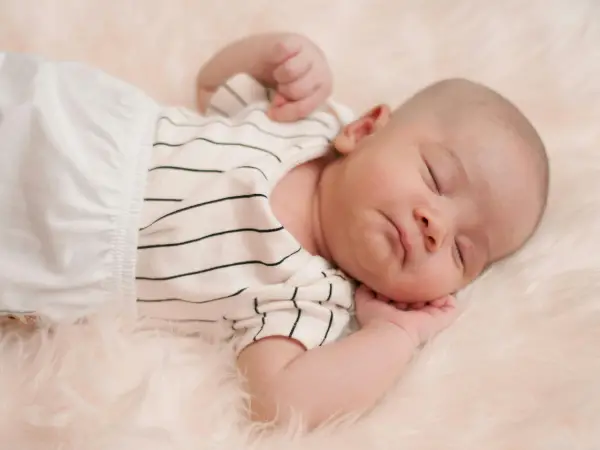
Nighttime Diapering
A proper diaper keeps your baby dry, cozy, and happy, reducing the chances of nighttime waking. Here’s a guide to help you navigate nighttime diapering effortlessly.
Choosing The Right Diaper
Selecting the best diaper for nighttime use is essential. Not all diapers are created equal. Look for diapers specifically designed for overnight use as they offer extra absorbency.
Consider the following factors when choosing a nighttime diaper:
- Absorbency: Ensure the diaper can hold a lot of liquid without leaking.
- Size: Choose the right size to avoid leaks and ensure comfort.
- Material: Opt for soft and breathable materials to prevent rashes.
Here’s a quick comparison table to help you decide:
| Brand | Absorbency Level | Material | Size Range |
|---|---|---|---|
| Pampers Newborn Swaddlers | High | Cotton Blend | Newborn to 5 |
| Huggies Little Snugglers Baby Diapers | Medium | Organic Cotton | 1 to 6 |
| Pampers Baby Dry Diapers | Very High | Hypoallergenic | 2 to 7 |
Ensuring Proper Fit
The fit of the diaper can make a huge difference in your baby’s comfort. A well-fitted diaper prevents leaks and ensures your baby stays dry throughout the night.
Here are some tips to ensure a proper fit:
- Check the Waistband: The waistband should sit snugly without being too tight.
- Leg Cuffs: Ensure the leg cuffs are turned outwards to prevent leaks.
- Proper Size: Always use the correct size based on your baby’s weight.
- Comfort: Check for any red marks on the skin, indicating the diaper might be too tight.
To help with fit, here’s a size guide based on weight:
| Weight Range (lbs) | Diaper Size |
|---|---|
| Up to 10 lbs | Newborn |
| 8-14 lbs | Size 1 |
| 12-18 lbs | Size 2 |
| 16-28 lbs | Size 3 |
| 22-37 lbs | Size 4 |
| 27+ lbs | Size 5 |
Adjusting the diaper correctly ensures your baby sleeps soundly through the night. Always double-check the fit after securing the diaper.
Creating A Comfortable Sleep Environment
Creating a comfortable sleep environment plays a crucial role in this. From maintaining the right room temperature to choosing the best sleep surface, every detail matters.
Maintaining Optimal Room Temperature
Keeping the room temperature just right is vital for your baby’s comfort. A room that’s too hot or too cold can disrupt their sleep. Here’s how to maintain the optimal room temperature:
- Ideal Temperature: Aim for a room temperature between 68-72°F (20-22°C).
- Use a Thermometer: Place a room thermometer in the nursery to monitor temperature.
- Adjust Clothing: Dress your baby in light layers to regulate body heat.
- Cooling and Heating Devices: Use fans or heaters cautiously. Ensure they are not directly pointed at the crib.
To help you keep track, here’s a quick reference table for ideal room temperatures and suitable clothing:
| Room Temperature | Recommended Clothing |
|---|---|
| 68-70°F (20-21°C) | Light sleep sack or onesie |
| 70-72°F (21-22°C) | Short-sleeve onesie or footed pajamas |
Considering Sleep Surface
The sleep surface is as important as room temperature. A safe and comfortable sleep surface can help your baby sleep better. Here are some key points:
- Firm Mattress: Use a firm mattress to support your baby’s back.
- Fitted Sheets: Use tight-fitting sheets that stay in place.
- Avoid Soft Bedding: Keep pillows, quilts, and soft toys out of the crib to prevent suffocation risks.
- Waterproof Covers: Use waterproof mattress covers to protect against spills and accidents.
Consider these additional tips for a perfect sleep surface:
- Breathable Materials: Choose breathable materials for crib sheets and mattresses to promote airflow.
- Regular Cleaning: Clean the crib mattress and sheets regularly to ensure a hygienic sleep environment.
- Check for Wear and Tear: Regularly inspect the mattress and bedding for any signs of wear and replace them if needed.
Ensuring the right sleep surface and room temperature can significantly improve your baby’s sleep quality. By paying attention to these details, you create a safe and comfortable sleep environment for your little one.
Frequently Asked Questions
What Is The Guide For Dressing Babies At Night?
Dress babies in light layers for night. Use breathable fabrics like cotton. Avoid overheating; keep room temperature around 68-72°F. Check baby’s neck for sweat. Always prioritize comfort and safety.
What Is The Best Thing For A Baby To Wear To Sleep?
A baby should wear a snug-fitting sleep sack or footed pajamas. Avoid loose blankets for safety. Choose breathable fabrics.
How Many Layers Should A Baby Wear At Night?
Dress your baby in one more layer than you would wear. Use breathable fabrics. Ensure comfort without overheating.
What Are The Guidelines For Baby Sleepwear?
Baby sleepwear should be flame-resistant or snug-fitting. Choose soft, breathable fabrics. Ensure there are no loose strings or buttons. Opt for sleepwear with easy diaper access. Always follow the manufacturer’s sizing guidelines.
Conclusion
Dressing your baby for sleep requires thoughtful consideration. Prioritize comfort, safety, and the right temperature. Choose soft, breathable fabrics and avoid overheating. Always follow safe sleep guidelines to ensure your baby sleeps soundly. With these tips, you can create a cozy and secure sleep environment for your little one.
